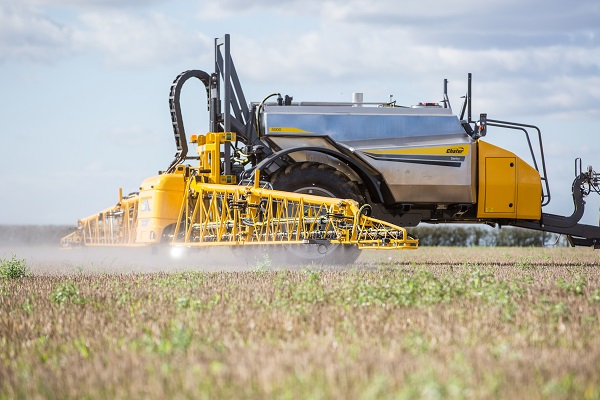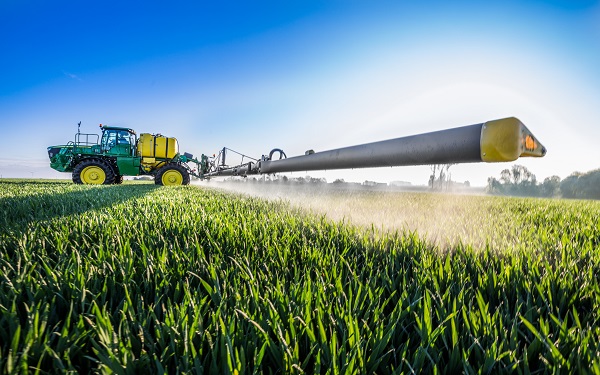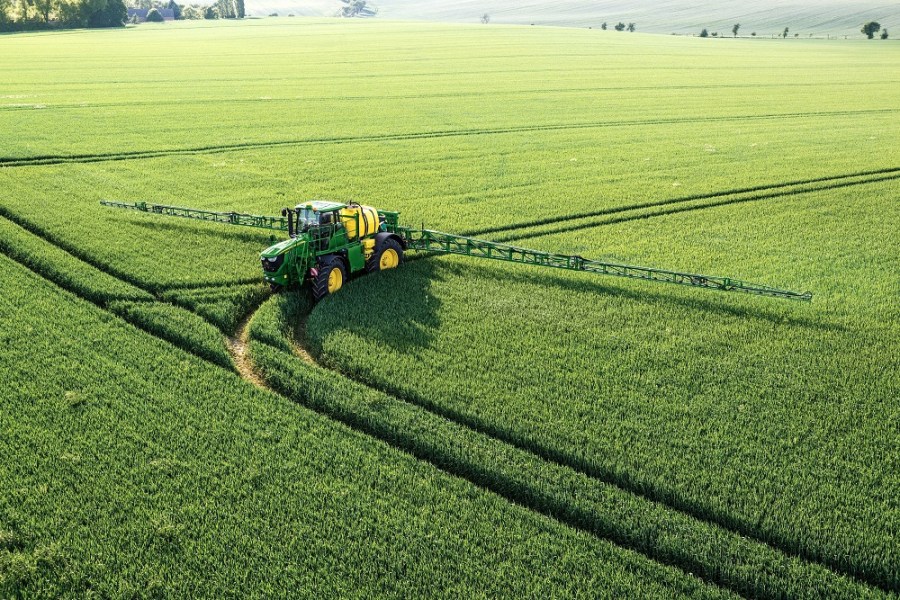Sprayer manufacturers have made great strides across model ranges to ensure chemical is delivered accurately to where it’s wanted with minimum loss to the environment. CPM looks at the latest developments.
Very few sprayers now go out onto farm without this level of section or nozzle control.
By David Jones
It’s hard to think of a specific farm machinery sector that’s had to adapt to environmental pressures on their mode and effects of operation more than crop sprayers. However, manufacturers have risen to the challenge by introducing technology to minimise drift, avoid field margins, enable night working and apply less product.
Chafer
A range of improvements have been applied to the company’s Sentry and Guardian trailed models for 2018, designed to provide greater accuracy of application, ease of operation and enhance reliability. Most noticeable, perhaps, is a new boom assembly that enables application from closer to the ground and therefore improves targeting of the crop.
In addition, there’s a new sliding frame which now has an extra set of rollers. Chafer explains that this has the effect of passing the extremities at both top and bottom of the mast to provide a wider range of travel and greater crop clearance. Boom control, too, is more readily achieved with a shortened raise and lower reaction time for the hydraulic functions.
A spray-system first is also being claimed for the abilities of Chafer’s ePlumbing system. It can now alert the operator if a valve isn’t hitting its intended target position, so removing the possibility of cross contamination.
The steering system has also benefited from some revisions. Sensors mounted on the sprayer have replaced the previous arrangement of potentiometer and linkage between tractor and machine. Besides giving greater steering sensitivity, there’s now no need for connection to the tractor, which, the company states, cuts the time taken to hitch/unhitch and provides greater reliability.

In lowering the boom height, Chafer has brought greater accuracy to the spray process.
Finally, ‘multiple’ updates have been made throughout the sprayers to boost reliability and longevity. One example is where the hoses and electric cabling pass through the mast assembly, a ladder system has been introduced to give greater protection to key components when the boom is being raised and lowered.
John Deere
The latest offering from JD’s sprayer research & development team – an updated incarnation of the R4040i self-propelled PowrSpray – made its debut at Cereals last year, with production at the Netherlands factory scheduled to get the first units here in the UK this spring. This 4000-litre capacity machine has been subjected to all-round enhancement providing greater accuracy and efficiency, together with a more comfortable working environment for the operator.
Highlights include a new QuadControl transmission with variable wheel motors and stepless speed control, obviating the need to change speed ranges manually. Wheelslip control now activates at each wheel individually, providing a boost to the machine’s performance on slopes – and, when the going gets tough, there’s now an electronic anti-stall system that automatically reduces forward speed.

John Deere has concentrated on enhancing operational precision and operator comfort.
In addition, a Cruise Control function gives operators the option to preset anticipated field and transport speeds.
At the heart of the machine, a 750 l/min spraying pump (with 1000 l/min available as an option) marries the two basic requirements of high output and spray accuracy. JD has abandoned the previous spray pressure regulators in favour of a pump that reacts to changes in spraying speed or application rate, but the combined pressure and flow-based rate control of the previous model has been retained.
Fendt Rogator
No, not a mistake – production of the former Challenger sprayer range continues as normal. That is, until the process reaches the paint shop at the factory in Holland – at which point green and red paint is now being applied instead of the yellow.
To be fair, this only applies to the 600 Series self-propelled machines. The Rogator 300 Series trailed sprayers are new models, with the first examples just starting to appear in the UK about now.
Operating widths range between 24m and 30m, with tank capacities of 3300, 4400, 5500 and 6600 litres. Fendt says that many of the benefits seen in its self-propelled models – precision linkage control, accurate handling, the chassis concept and all-round reliability – have been carried across from the 600 Series.
At the heart of these trailed sprayers, Fendt’s design engineers have managed to transfer the rigid single beam chassis concept from the self-propelled counterpart, adding a universal drawbar to the front section. The specification enables users to switch between a clevis-style coupling and a hitch-type connection to suit different tractors and tyre sizes.
As a compact machine with a low centre of gravity, the Rogator 300 has the axle sited far to the rear, while the single beam chassis allows the OptiSteer mechanism to create a steering angle of 35°. This, it is said, maximises manoeuvrability and protection of the crop – even when high and wide tyres are fitted. Ground clearance is up to 85cm.
Amazone
UK farmers who ordered mounted sprayers belonging to Amazone’s latest generation of machines – when they were introduced towards the end of 2017 – will have started to take delivery by now. Some of them will be UF 2002 models with their tank volume of 2000 litres and operator-friendly design.
A Super-S2 boom, available in working widths of between 15m and 50m, can also be supplemented by a front tank to increase capacity by a further 1000 litres. Said to have a centre of gravity that eases the mounting procedure, the UF 2002 also has a quick-coupling system and easy-parking mechanism. The filling station is covered to protect against dirt contamination and water splash.
Options include the AmaSwitch individual nozzle-switching mechanism that facilitates 50cm part-width section control. The tank has been shaped specifically to integrate with the main frame to provide the set-up with a favourable centre of gravity. Inside, the tank is completely smooth which, in combination with the low siting of the sump at the base of the tank, permits effective cleaning and minimises residual volumes.
Tank filling, either on the suction side or when pressure filling from a water source, takes place close to the tank bottom to avoid the formation of foam. Similarly, the agitator is positioned on the tank bottom to promote intensive agitation and prevent any deposits from building up.
- For more, see On Farm Opinion.
Lemken
Launched at Agritechnica and now available on Lemken ISOBUS-compatible sprayers in the UK is the new CCI-1200 control terminal. This covers the Vega 12 and Sirius 12 range of sprayers, while ISOBUS is an option on the Albatross trailed and other sprayers.
The new termninal features a 12.1in touch-screen display you can mount either portrait or landscape, says the firm’s Paul Creasy. “It’s fully ISOBUS-compatible, and the beauty of this new terminal is that you can control two machines through just one screen.”
The display can be split to show several applications at the same time. So if using a Solitair/Azurit combination for maize seeding, for example, the CCI-1200 takes over the function of two universal terminals. When spraying, the controls can now be displayed together with a map for GPS-controlled width section control, for example.
There’s a range of apps available for the CCI controller that bring part-width section control and interface with your farm management software, for example. Launched by the CCI consortium of manufacturers – Grimme, Krone, Kuhn, Lemken and Rauch – the same terminal can also be used to control other compatible implements. “Plug in a Grimme potato harvester and the screen boots up accordingly,” adds Paul.
Individual nozzle control is available on the Vega and Sirius sprayers, he notes, that improve accuracy as well as environmental performance. On the Albatross, up to 13 sections of the spray boom can be controlled individually. “Users find they recoup the extra cost in chemical savings within two seasons – very few sprayers now go out onto farm without this level of section or nozzle control.”
In addition, Boom Command controls boom height independently on either side from the centre of the sprayer, allowing the spray boom to follow ground contours.
Househam
A recent market debutant from the Lincs manufacturer is the Predator, a self-propelled machine designed to take advantage of the latest large wheel and tyre technology. It can be specified with two very different tyre/wheel options – Michelin SprayBib 380/90 R46 rowcrop or 650/60 R38 low ground pressure tyres.
The company has clearly spent time addressing the challenges of stability and manoeuvrability that a machine of this size would normally pose. Its design engineers have come up with a 5000-litre capacity model (4000 is also available), weighing just below 10.5t, with a 36m boom and row crop wheels, that’s lighter than anything of similar size and exerts less pressure on the ground. Larger capacity machines are still in the course of development.
Other technical features include individual nozzle control, a new hydraulic suspension system, Househam’s own Total Machine Control, V5 controller with FieldMaster GPS mapping and guidance, load sense hydraulics, NORAC variable geometry boom levelling and a full illumination package.
Horsch
Multiple upgrades to the company’s popular Leeb GS trailed sprayer were revealed at Agritechnica a few months ago. New variants comprising ECO, CCS (Continuous Cleaning System) and CCS Pro are now available, with a choice of stainless steel tank capacities – 6000, 7000 or 8000 litres – all three governed by Horsch-developed software and intuitive electronics.
The Leeb GS can be specified with boom widths of between 18m and 42m. Range-topping BoomControl Pro has been designed to ensure that the boom stays close to the crop at all times for enhanced penetration of the crop and to minimise drift. The system maintains a distance from the target crop of less than 40cm while travelling at speeds of up to 40km/h.
There are 12 possible nozzle configurations at 25cm spacing, allowing users to dictate their most appropriate boom set-up.
Horsch has also been working on machine manoeuvrability and now offers the option of fully integrated axle steering with assistance of a gyroscope. Mounted on the axle, this allows the sprayer to follow the course of the tractor precisely, without the need for a data link between the two. Only the hydraulics, brake, light and ISOBUS need to be connected to the tractor.
The sprayer’s axle is air suspended, with level regulation, and track widths from 1.8m to 2.25m are available. Other, individually specified track widths can also be accommodated.
Landquip
The Suffolk company’s latest sprayer model on the market is the CV Self-Propelled. With a hydraulically-driven motor on each wheel, the design eliminates the need for a mechanical axle, so reducing the potential for damage to the crop. Besides giving the operator better forward vision, the positioning of the panoramic cab also allows the sprayer pack to sit more centrally on the chassis, at the same time achieving better overall weight distribution.
There’s range of tank sizes – 3000, 3500 and 4000-litre in fibreglass, 5000 and 6000-litre in stainless steel – and a choice of Alu-light booms from 18m to 40m, which also assist in the even distribution of weight. Standard clearance is 1.0m, with options up to 1.6m, and the transport width can be 2.6m, 2.8m or 3.0m, depending on the boom specified. Either two or four-wheel steering can be selected to counter any changes in operating conditions.
Machine weights aren’t too demanding on the ground, given their dimensions, with a 4000-litre, 30m CV225 coming in at 7440kg, for example, and the 3500-litre, 24m CV170 version weighing 6500kg. Power is provided by Caterpillar engines – 170, 210 or 225hp, depending on the model.
Berthoud
Never far from the rostrum, the company was awarded the accolade ‘Sprayer of the Year’ at the SIMA event in Paris – this time with its new Vantage trailed machine. Described by the manufacturer as offering growers precise application, high working speed and comfort in operation, the Vantage has inherited a number of features from the Tenor range, which it replaces.
These include the Omega pump, Actiflex II axle suspension and Berlogic instrument panel. Five models make up the range – tank capacities 2800, 3500, 4300, 5500 and 6700 litres – and can accommodate three boom types, ranging between 24m and 44m.
Berthoud has also introduced a line-up of what it calls ‘mid-range’ mounted sprayers – the Hermes. With a new, modern design that cuts ‘overhang’ by up to 30cm when compared with its predecessor, the Hermes’ closer coupling and centre of gravity is said to improve weight distribution, allowing it to be used with smaller tractors.
The choice of spec includes tank capacities of 800, 1000 and 1200 litres and a new range of rear-folding booms at 15, 16 or 18m. The new booms rely on the Axiale central pivot system for their performance and stability on inclines, turns and headlands, while its compact L-shaped structure keeps the machine to a transport width of 2.55m.




